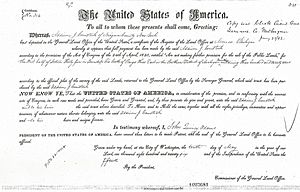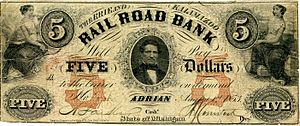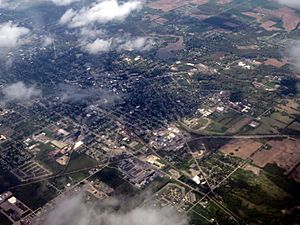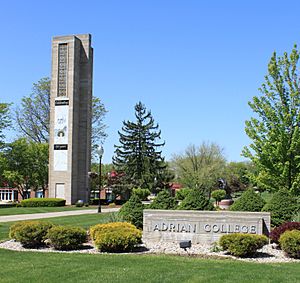Adrian, Michigan facts for kids
Quick facts for kids
Adrian, Michigan
|
|
|---|---|
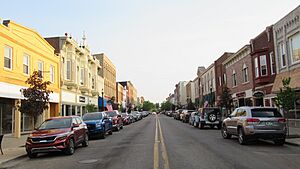
Downtown Adrian along Main Street (2023)
|
|
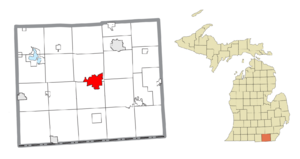
Location within Lenawee County
|
|
| Country | United States |
| State | Michigan |
| County | Lenawee |
| Founded | 1826 |
| Incorporated | 1836 (village) 1853 (city) |
| Government | |
| • Type | City commission |
| Area | |
| • Total | 8.16 sq mi (21.12 km2) |
| • Land | 8.01 sq mi (20.74 km2) |
| • Water | 0.15 sq mi (0.38 km2) |
| Elevation | 787 ft (240 m) |
| Population
(2020)
|
|
| • Total | 20,645 |
| • Density | 2,578.37/sq mi (995.49/km2) |
| Time zone | UTC-5 (Eastern (EST)) |
| • Summer (DST) | UTC-4 (EDT) |
| ZIP code(s) |
49221
|
| Area code(s) | 517 |
| FIPS code | 26-00440 |
| GNIS feature ID | 0619846 |
Adrian is a city in the state of Michigan, USA. It's the main city, or "county seat," of Lenawee County. In 2020, about 20,645 people lived there. Adrian is part of Michigan's 5th congressional district.
Contents
History of Adrian
Adrian was started on June 18, 1826, by Addison Comstock. The village was first called Logan. Later, its name was changed to Adrian. This might have been a nod to the Roman emperor Hadrian.
Michigan's first working railroad was in Adrian. It was a horse-drawn train that ran between Adrian and Toledo in 1836. Adrian grew quickly. When Michigan became a state in 1837, Adrian was the sixth largest city. By 1860, it was the third largest. Adrian became a village on March 28, 1836, and then a city on January 31, 1853.
The Underground Railroad
In 1831, a group of Quakers in Southeast Michigan formed their first church. They also created a secret network of safe houses. This network was part of the Underground Railroad in the Raisin River Valley. This was a system that helped enslaved people find freedom.
Daniel Smith was an early leader of the Raisin Valley Friends Meeting House. His daughter, Laura Smith Haviland, became a famous activist. She worked for equal rights and helped many people escape slavery. In 1832, Elizabeth Margaret Chandler started the Logan Female Anti-Slavery Society. This group worked against slavery. The Adrian-Tecumseh Underground Railroad network was set up by a Baptist minister in northern Lenawee County.
Adrian in the Late 1800s and 1900s
A stone pillar from the old Bank of Pennsylvania was moved to Adrian. It became a Civil War Memorial. It honors the people from Adrian who died in the American Civil War.
In the late 1800s and early 1900s, Adrian was known as the "fence capital of the world." This was because J. Wallace Page invented the first successful wire fence. Adrian became famous for making fences. These fences were sent all over the world, even to New York, Berlin, Asia, and Africa. The company also sponsored a successful Black baseball team called the Page Fence Giants.
Adrian was also an early center for making cars. One of the first cars, the Lion automobile, was made here. Between 1900 and 1912, three main car models were made in Adrian. Besides the Lion, the Murry Motor Car and Lenawee Car were made by the Church Manufacturing Company. Adrian seemed set to be a major car-making city. However, bad money decisions and a fire at the Lion Automobile factory in 1912 caused both companies to close.
Throughout the 1900s, Adrian kept growing. Its size doubled, but at a slower rate than Michigan as a whole.
Geography of Adrian
Adrian is about 30 miles (48 km) southwest of Ann Arbor. It's also about 30 miles (48 km) southeast of Jackson. And it's 30 miles (48 km) northwest of Toledo, Ohio.
A part of the city is on the edge of Adrian Township and Madison Charter Township. However, Adrian is a separate city. The city's developed area goes beyond its official borders. It extends into these townships and also into nearby Raisin Township and Palmyra Township.
The United States Census Bureau says the city covers a total area of 8.10 square miles (21.0 km²). Of this, 7.95 square miles (20.6 km²) is land, and 0.15 square miles (0.39 km²) is water.
The town is about 15 miles (24 km) southeast of the Irish Hills area of Michigan. This area is known for its many lakes and rolling hills. It's also home to the Irish Famine Memorial and Michigan International Speedway. Many people from Adrian enjoy boating and other fun activities in this area. Devils Lake, Round Lake, Posey Lake, and Wamplers Lake are popular places to visit on weekends.
Adrian's Climate
| Climate data for Adrian 2 NNE, Michigan (1991–2020 normals, extremes 1887–present) | |||||||||||||
|---|---|---|---|---|---|---|---|---|---|---|---|---|---|
| Month | Jan | Feb | Mar | Apr | May | Jun | Jul | Aug | Sep | Oct | Nov | Dec | Year |
| Record high °F (°C) | 68 (20) |
70 (21) |
85 (29) |
92 (33) |
99 (37) |
106 (41) |
108 (42) |
107 (42) |
104 (40) |
91 (33) |
80 (27) |
69 (21) |
108 (42) |
| Mean daily maximum °F (°C) | 33.3 (0.7) |
36.4 (2.4) |
46.9 (8.3) |
59.9 (15.5) |
71.8 (22.1) |
81.0 (27.2) |
84.7 (29.3) |
82.5 (28.1) |
75.9 (24.4) |
63.1 (17.3) |
49.2 (9.6) |
37.9 (3.3) |
60.2 (15.7) |
| Daily mean °F (°C) | 25.1 (−3.8) |
27.2 (−2.7) |
36.4 (2.4) |
48.0 (8.9) |
59.2 (15.1) |
68.8 (20.4) |
72.5 (22.5) |
70.7 (21.5) |
63.5 (17.5) |
51.6 (10.9) |
39.8 (4.3) |
30.3 (−0.9) |
49.4 (9.7) |
| Mean daily minimum °F (°C) | 16.9 (−8.4) |
18.0 (−7.8) |
25.9 (−3.4) |
36.1 (2.3) |
46.7 (8.2) |
56.5 (13.6) |
60.3 (15.7) |
58.8 (14.9) |
51.0 (10.6) |
40.2 (4.6) |
30.5 (−0.8) |
22.6 (−5.2) |
38.6 (3.7) |
| Record low °F (°C) | −26 (−32) |
−24 (−31) |
−8 (−22) |
5 (−15) |
20 (−7) |
33 (1) |
41 (5) |
32 (0) |
26 (−3) |
15 (−9) |
−5 (−21) |
−17 (−27) |
−26 (−32) |
| Average precipitation inches (mm) | 2.24 (57) |
1.99 (51) |
2.49 (63) |
3.49 (89) |
3.99 (101) |
4.10 (104) |
3.40 (86) |
3.63 (92) |
3.29 (84) |
2.95 (75) |
2.82 (72) |
2.29 (58) |
36.68 (932) |
| Average snowfall inches (cm) | 9.0 (23) |
5.8 (15) |
4.1 (10) |
1.0 (2.5) |
0.0 (0.0) |
0.0 (0.0) |
0.0 (0.0) |
0.0 (0.0) |
0.0 (0.0) |
0.0 (0.0) |
1.3 (3.3) |
4.8 (12) |
26.0 (66) |
| Average precipitation days (≥ 0.01 in) | 11.7 | 9.0 | 10.4 | 11.8 | 12.4 | 10.0 | 9.4 | 9.5 | 9.4 | 10.8 | 10.2 | 10.8 | 125.4 |
| Average snowy days (≥ 0.1 in) | 6.5 | 5.5 | 2.4 | 0.4 | 0.0 | 0.0 | 0.0 | 0.0 | 0.0 | 0.0 | 1.1 | 4.5 | 20.4 |
| Source: NOAA | |||||||||||||
People of Adrian
| Historical population | |||
|---|---|---|---|
| Census | Pop. | %± | |
| 1850 | 2,219 | — | |
| 1860 | 6,213 | 180.0% | |
| 1870 | 8,438 | 35.8% | |
| 1880 | 7,849 | −7.0% | |
| 1890 | 8,756 | 11.6% | |
| 1900 | 9,654 | 10.3% | |
| 1910 | 10,763 | 11.5% | |
| 1920 | 11,878 | 10.4% | |
| 1930 | 13,064 | 10.0% | |
| 1940 | 14,230 | 8.9% | |
| 1950 | 18,393 | 29.3% | |
| 1960 | 20,347 | 10.6% | |
| 1970 | 20,382 | 0.2% | |
| 1980 | 21,276 | 4.4% | |
| 1990 | 22,097 | 3.9% | |
| 2000 | 21,574 | −2.4% | |
| 2010 | 21,133 | −2.0% | |
| 2020 | 20,645 | −2.3% | |
| U.S. Decennial Census | |||
Adrian's Population in 2010
In 2010, Adrian had 21,133 people living in 7,831 households. The city had about 2,658 people per square mile (1,026 per km²). There were 8,977 homes.
Most residents (84.1%) were White. About 4.4% were African American, and 0.6% were Native American. About 0.9% were Asian, and 5.9% were from other races. About 4.0% were from two or more races. People of Hispanic or Latino background made up 18.8% of the population.
About 31.7% of households had children under 18. About 35.8% were married couples. About 16.7% had a female head of household with no husband. About 5.3% had a male head of household with no wife. And 42.1% were not families.
The average age in Adrian was 32.5 years. About 23% of residents were under 18. About 17.2% were between 18 and 24. About 23.5% were between 25 and 44. About 22.1% were between 45 and 64. And 14.2% were 65 or older. The city was 47.8% male and 52.2% female.
Adrian's Economy
Top Employers in Adrian
Here are the top employers in Adrian, based on a 2021 report:
| # | Employer | # of Employees |
|---|---|---|
| 1 | Lenawee County | 564 |
| 2 | Siena Heights University | 498 |
| 3 | Adrian College | 400 |
| 4 | Adrian Public Schools | 400 |
| 5 | Lenawee Intermediate School District | 366 |
| 6 | Inteva Products | 329 |
| 7 | Adrian Dominican Sisters | 328 |
| 8 | Adrian Steel | 300 |
| 9 | Inergy | 256 |
| 10 | Lenawee Christian School | 133 |
Culture and Life in Adrian
Adrian is sometimes called "the Maple City." This is because many sugar maple and other maple trees grow there. The sports teams at Adrian High School are called the "Adrian Maples." Also, many local businesses use "maple" in their names.
Adrian has a rich cultural history dating back to the mid-1800s. The Adrian City Band is one of the oldest community bands in the country. It was started in 1838. The Croswell Opera House is the oldest theater in Michigan. The Adrian Symphony Orchestra began in 1981. Both Adrian College and Siena Heights University offer many cultural events.
Heritage Park and Trestle Park have fun outdoor activities. They offer mountain bike trails and boardwalks along the river. Trestle Park also has a walking path on an old railroad bridge.
Education in Adrian
Adrian Public Schools serves students in Adrian and nearby areas.
Madison School District is located on the east side of Adrian.
Lenawee Christian School is a private Christian school for grades K-12. It's on the west side of Adrian.
St. Stephen Lutheran School is a Christian school for PreK-8 students. It is part of the Wisconsin Evangelical Lutheran Synod.
There are three colleges and universities in Adrian:
- Adrian College
- Siena Heights University
- Jackson College
Media in Adrian
Adrian has two newspapers. The Daily Telegram started in 1892. It is published every day and is owned by Gannett. A new independent monthly newspaper, The Lenawee Voice, began in 2023.
Local radio stations include WABJ 1490 AM, which mainly plays talk shows. WLEN – 103.9 and 96.5 FM plays news. WQTE 95.3 FM plays country music. WVAC 107.9 FM is a student-run radio station from Adrian College. WBCL from Fort Wayne also has a station in Adrian at 97.7 FM.
Adrian also receives radio and TV signals from Ann Arbor, Toledo, and Jackson. Some Detroit broadcasters can also be heard or seen in parts of the area.
Notable people
Major Highways
 US 223
US 223


 Bus. US 223
Bus. US 223 M-34
M-34 M-52
M-52
See also
 In Spanish: Adrian (Míchigan) para niños
In Spanish: Adrian (Míchigan) para niños




